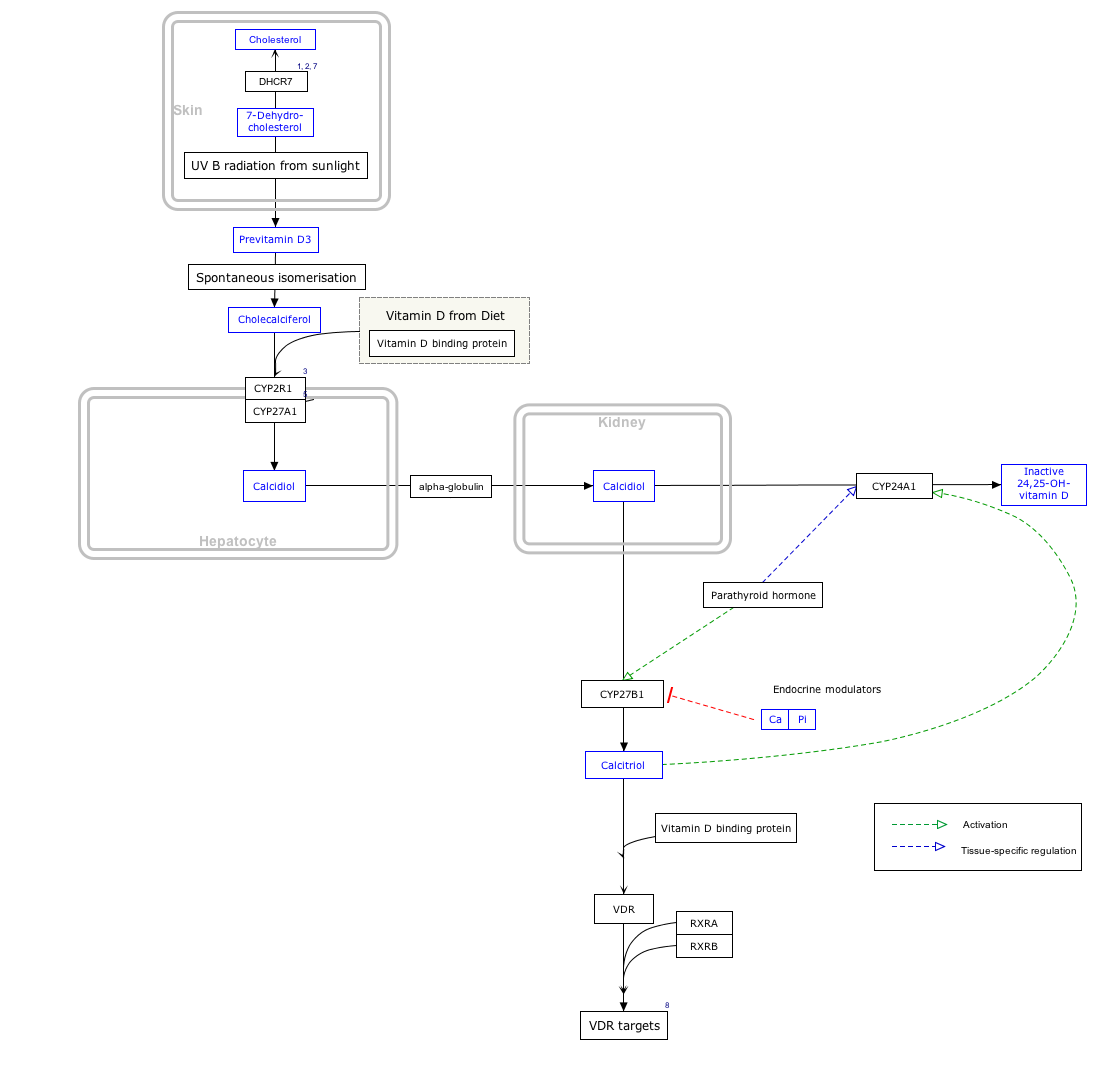Calcitriol/ja: Difference between revisions
Created page with "カルシトリオールの作用の多くは、ビタミンD受容体またはVDRとも呼ばれるカルシトリオール受容体との相互作用によって媒介される。例えば、腸上皮細胞におけるカルシトリオール受容体の非結合不活性型は細胞質に存在する。カルシトリオールが受容体に結合すると、リガンド-受容体複合体がce..." |
Created page with "==インタラクティブ経路マップ== {{VitaminDSynthesis_WP1531|highlight=Calcifediol}}" |
||
| (6 intermediate revisions by the same user not shown) | |||
| Line 140: | Line 140: | ||
カルシトリオールの作用の多くは、ビタミンD受容体またはVDRとも呼ばれる[[calcitriol receptor/ja|カルシトリオール受容体]]との相互作用によって媒介される。例えば、腸上皮細胞におけるカルシトリオール受容体の非結合不活性型は[[cytoplasm/ja|細胞質]]に存在する。カルシトリオールが受容体に結合すると、[[Ligand (biochemistry)/ja|リガンド]]-受容体複合体が[[cell nucleus/ja|細胞核]]に移動し、そこで[[Vitamin D-dependent calcium-binding protein/ja|カルシウム結合タンパク質]]をコードする遺伝子の発現を促進する[[transcription factor/ja|転写因子]]として働く。カルシウム結合タンパク質のレベルが上昇すると、細胞はより多くのカルシウム({{chem|Ca|2+}})を腸から[[intestinal mucosa/ja|腸粘膜]]を横切って血液中に積極的に輸送できるようになる。別の''非ゲノム的''経路は、[[PDIA3/ja|PDIA3]]またはVDRを介して媒介される。 | カルシトリオールの作用の多くは、ビタミンD受容体またはVDRとも呼ばれる[[calcitriol receptor/ja|カルシトリオール受容体]]との相互作用によって媒介される。例えば、腸上皮細胞におけるカルシトリオール受容体の非結合不活性型は[[cytoplasm/ja|細胞質]]に存在する。カルシトリオールが受容体に結合すると、[[Ligand (biochemistry)/ja|リガンド]]-受容体複合体が[[cell nucleus/ja|細胞核]]に移動し、そこで[[Vitamin D-dependent calcium-binding protein/ja|カルシウム結合タンパク質]]をコードする遺伝子の発現を促進する[[transcription factor/ja|転写因子]]として働く。カルシウム結合タンパク質のレベルが上昇すると、細胞はより多くのカルシウム({{chem|Ca|2+}})を腸から[[intestinal mucosa/ja|腸粘膜]]を横切って血液中に積極的に輸送できるようになる。別の''非ゲノム的''経路は、[[PDIA3/ja|PDIA3]]またはVDRを介して媒介される。 | ||
電気的中性の維持には、腸上皮細胞によって触媒される{{chem|Ca|2+}}イオンの輸送が、主に無機リン酸塩などの対イオンを伴うことが必要である。したがって、カルシトリオールはリン酸塩の腸管吸収も促進する。 | |||
カルシトリオールが骨からのカルシウムの放出を刺激するという観察は、十分な血清カルシトリオールレベルが一般に骨からのカルシウムの全体的喪失を防ぐことを考えると、矛盾しているように思われる。カルシトリオール刺激による腸管へのカルシウム取り込みによって血清カルシウム濃度が上昇すると、破骨細胞のホルモン刺激によって失われる以上のカルシウムが骨に取り込まれると考えられている。食事性カルシウムの欠乏や腸管輸送の障害など、血清カルシウムの減少をもたらす条件がある場合にのみ、骨からのカルシウムの全体的な喪失が起こる。 | |||
カルシトリオールはまた、主に骨からのカルシウム放出を阻害することによって血中カルシウムを減少させるホルモンである[[calcitonin/ja|カルシトニン]]の放出を阻害する。 | |||
== 生合成とその制御{{Anchor|Biosynthesis and its regulation}} == | |||
== Biosynthesis and its regulation == | [[Image:Calcitriol-Synthesis.png|thumb|カルシトリオール合成]] | ||
[[Image:Calcitriol-Synthesis.png|thumb| | カルシトリオールは、腎臓の[[nephron/ja|ネフロン]]の[[proximal tubule/ja|近位尿細管]]の細胞内で、[[25-Hydroxyvitamin D3 1-alpha-hydroxylase/ja|25-ヒドロキシビタミンD<sub>3</sub> 1-α-ヒドロキシラーゼ]]の作用によって産生される、 [[mitochondria/ja|ミトコンドリア]]内の[[oxygenase/ja|オキシゲナーゼ]]であり、[[Calcifediol/ja|25-ヒドロキシコレカルシフェロール(カルシフェジオール)]]の1-α位の[[hydroxylation/ja|水酸化]]を触媒する[[enzyme/ja|酵素]]である。 | ||
この酵素の活性はPTHによって刺激される。これは[[Calcium metabolism/ja|Ca<sup>2+</sup>恒常性]]における重要な制御点である。カルシトリオールの産生に対するさらなる影響としては、[[prolactin/ja|プロラクチン]]による増加がある。このホルモンは、大量のカルシウムを必要とする[[lactogenesis/ja|乳汁生成]]([[mammary glands/ja|乳腺]]における乳汁の形成)を刺激する。活性はまた、高濃度の血清リン酸および骨の骨細胞細胞によるホルモン[[FGF23/ja|FGF23]]の産生の増加によっても低下する。 | |||
カルシトリオールは腎臓以外でも、[[placenta/ja|胎盤]]や活性化[[macrophages/ja|マクロファージ]]など多くの組織で少量生産されている。 | |||
[[alfacalcidol/ja|アルファカルシドール]]という薬物を用いると、肝臓で25-水酸化が起こり、活性代謝物としてカルシトリオールが生成される。これは、腎1-α-水酸化酵素を失った腎疾患患者において、他のビタミンD前駆体よりも大きな効果をもたらす。 | |||
==インタラクティブ経路マップ== | |||
{{VitaminDSynthesis_WP1531|highlight=Calcifediol}} | |||
{{ | |||
===代謝=== | |||
体内でのカルシトリオールの半減期は、その前駆体であるカルシフェジオールの半減期が数週間であるのとは異なり、数時間で測定される。カルシトリオールは、1,24,25-トリヒドロキシビタミンD、[[calcitroic acid/ja|カルシトロイン酸]]を形成するためにさらなる水酸化によって不活性化される。これはCYP24A1[[CYP24A1/ja|24-水酸化酵素]]の作用によって起こる。カルシトロイン酸は水に溶けやすく、胆汁および尿中に排泄される。 | |||
==歴史{{Anchor|History}}== | ==歴史{{Anchor|History}}== | ||
Latest revision as of 21:50, 12 April 2024
 | |
 | |
| Clinical data | |
|---|---|
| Pronunciation | US: /ˌkælsɪˈtraɪɒl/; UK: /kælˈsɪtriɒl/ |
| Trade names | Rocaltrol, Calcijex, Decostriol, others |
| Other names | 1,25-dihydroxycholecalciferol, 1alpha,25-dihydroxyvitamin D3, 1,25-dihydroxyvitamin D3, 1α,25-(OH)2D3, 1,25(OH)2D |
| AHFS/Drugs.com | Monograph |
| MedlinePlus | a682335 |
| License data |
|
| Pregnancy category |
|
| Routes of administration | 経口, intravenous/ja |
| ATC code | |
| Legal status | |
| Legal status | |
| Pharmacokinetic data | |
| Protein binding | 99.9% |
| Metabolism | Kidney |
| Elimination half-life | 5~8時間(大人)、27時間(子供) |
| Excretion | 糞便(50%)、尿(16%) |
| Identifiers | |
| |
| CAS Number | |
| PubChem CID | |
| IUPHAR/BPS | |
| DrugBank | |
| ChemSpider | |
| UNII | |
| KEGG | |
| ChEBI | |
| ChEMBL | |
| PDB ligand | |
| Chemical and physical data | |
| Formula | C27H44O3 |
| Molar mass | 416.646 g·mol−1 |
| 3D model (JSmol) | |
| |
| |
| (verify) | |
カルシトリオールはビタミンDの活性型であり、通常は腎臓で作られる。別名1,25-ジヒドロキシコレカルシフェロールとも呼ばれる。カルシトリオールはホルモンであり、細胞核内のビタミンD受容体に結合して活性化し、多くの遺伝子の発現を増加させる。カルシトリオールは、主に腸からのカルシウムの取り込みを増加させることによって、血液中の生物におけるカルシウム(Ca2+)を増加させる。
腎臓病による低血中カルシウム血症や副甲状腺機能亢進症、副甲状腺機能低下症による低血中カルシウム血症、骨粗鬆症、骨軟化症、家族性低リン血症の治療薬として投与され、経口または静脈への注射で服用できる。過剰量または過剰摂取は、脱力感、頭痛、吐き気、便秘、尿路感染症、腹痛を引き起こす可能性がある。重篤な副作用には、高血中カルシウムやアナフィラキシーがある。医薬品投与開始後および投与量変更時には、定期的な血液検査が推奨される。
カルシトリオールは1971年に活性型ビタミンDとして同定され、1978年に米国で医薬品として承認された。ジェネリック医薬品として販売されている。2021年には、1 万以上の処方で、米国で258番目に多く処方された医薬品であった。世界保健機関の必須医薬品リストに掲載されている。
医薬用途
カルシトリオールは以下の目的で処方される:
カルシトリオールは乾癬の治療に軟膏として使用されているが、ビタミンDアナログであるカルシポトリオール(カルシポトリエン)の方がより一般的に使用されている。カルシトリオールはまた、乾癬および乾癬性関節炎の治療のために経口投与されている。カルシトリオールおよび他のVDR-リガンド類似体の非吸収作用に関する研究、およびそれらの治療応用の可能性については、総説がある。
副作用
カルシトリオール療法に伴う主な副作用は高カルシウム血症であり、初期症状には以下が含まれる: 吐き気、嘔吐、便秘、食欲不振、無気力、頭痛、口渇、そう痒症、発汗、および/または多尿などである。臨床使用されている他のビタミンD化合物(コレカルシフェロール、エルゴカルシフェロール)と比較して、カルシトリオールは高カルシウム血症を誘発するリスクが高い。しかしながら、比較的短い半減期のため、そのようなエピソードは短く、治療が容易であろう。
カルシトリオール高値は、サプリメントを服用していない患者におけるヒトの疾患状態でもみられることがある。高カルシウム血症でカルシトリオール値が高い患者では、通常、無傷の副甲状腺ホルモン値が低い。
カルシトリオール濃度の上昇による高カルシウム血症を伴う主な疾患は、リンパ腫、結核およびサルコイドーシスであり、マクロファージに発現する異所性25(OH)D-1-水酸化酵素(CYP27B1)によって過剰産生が起こる。 似たような所見をもたらす他の疾患には以下のものがある:
- 真菌感染症;ニューモシスティス・ジロヴェシ、ヒストプラスマ症、コクシジオイデス真菌症、パラコクシジオイデス真菌症、カンジダ症
- その他の肉芽腫性疾患;PR3+血管炎、クローン病、急性肉芽腫性肺炎、タルク肉芽腫、シリコン誘発肉芽腫、BCG関連、肉芽腫性肝炎、パラフィン関連肉芽腫
- 遺伝性疾患;ウィリアムズ症候群、弾性線維性仮性黄色腫、CYP24A1突然変異(成人/小児)、SLC34A1突然変異
- その他の疾患;マイコバクテリウム・アビウム、ハンセン病、リポイド肺炎、猫ひっかき病、ベリリア症
植物の中には1,25-ジヒドロキシコレカルシフェロールの配糖体を含むものがある。放牧動物がこれらの配糖体を摂取するとビタミンD中毒を引き起こし、軟組織にカルシウムが過剰に沈着する石灰沈着症を引き起こす。これらの配糖体を含む放牧地植物としては、Cestrum diurnum、Solanum malacoxylon、Trisetum flavescensの3種が知られている。これらのうち、C. diurnumだけがアメリカ、主にフロリダで発見されている。
作用機序
カルシトリオールは、以下のようにして血中カルシウム濃度([Ca2+
])を上昇させる:
- 消化管からの食事性カルシウムの吸収を促進する。
- カルシウムの腎尿細管再吸収を増加させ、尿中のカルシウム損失を減少させる。
- 骨からのカルシウムの放出を刺激する。そのためには、骨芽細胞と呼ばれる特定のタイプの骨細胞に作用して、RANKLを放出させ、その結果破骨細胞を活性化させる。
カルシトリオールは、これら3つの役割すべてにおいて副甲状腺ホルモン(PTH)と協調して働く。例えば、PTHは間接的に破骨細胞も刺激する。しかし、PTHの主な作用は、Ca2+
の対イオンである無機リン酸塩(Pi)を腎臓から排泄する速度を増加させることである。その結果、血清リン酸が減少すると、ヒドロキシアパタイト(Ca5(PO4)3OH)が骨から溶け出し、血清カルシウムが増加する。PTHはまた、カルシトリオール(下記参照)の産生を刺激する。
カルシトリオールの作用の多くは、ビタミンD受容体またはVDRとも呼ばれるカルシトリオール受容体との相互作用によって媒介される。例えば、腸上皮細胞におけるカルシトリオール受容体の非結合不活性型は細胞質に存在する。カルシトリオールが受容体に結合すると、リガンド-受容体複合体が細胞核に移動し、そこでカルシウム結合タンパク質をコードする遺伝子の発現を促進する転写因子として働く。カルシウム結合タンパク質のレベルが上昇すると、細胞はより多くのカルシウム(Ca2+
)を腸から腸粘膜を横切って血液中に積極的に輸送できるようになる。別の非ゲノム的経路は、PDIA3またはVDRを介して媒介される。
電気的中性の維持には、腸上皮細胞によって触媒されるCa2+
イオンの輸送が、主に無機リン酸塩などの対イオンを伴うことが必要である。したがって、カルシトリオールはリン酸塩の腸管吸収も促進する。
カルシトリオールが骨からのカルシウムの放出を刺激するという観察は、十分な血清カルシトリオールレベルが一般に骨からのカルシウムの全体的喪失を防ぐことを考えると、矛盾しているように思われる。カルシトリオール刺激による腸管へのカルシウム取り込みによって血清カルシウム濃度が上昇すると、破骨細胞のホルモン刺激によって失われる以上のカルシウムが骨に取り込まれると考えられている。食事性カルシウムの欠乏や腸管輸送の障害など、血清カルシウムの減少をもたらす条件がある場合にのみ、骨からのカルシウムの全体的な喪失が起こる。
カルシトリオールはまた、主に骨からのカルシウム放出を阻害することによって血中カルシウムを減少させるホルモンであるカルシトニンの放出を阻害する。
生合成とその制御

カルシトリオールは、腎臓のネフロンの近位尿細管の細胞内で、25-ヒドロキシビタミンD3 1-α-ヒドロキシラーゼの作用によって産生される、 ミトコンドリア内のオキシゲナーゼであり、25-ヒドロキシコレカルシフェロール(カルシフェジオール)の1-α位の水酸化を触媒する酵素である。
この酵素の活性はPTHによって刺激される。これはCa2+恒常性における重要な制御点である。カルシトリオールの産生に対するさらなる影響としては、プロラクチンによる増加がある。このホルモンは、大量のカルシウムを必要とする乳汁生成(乳腺における乳汁の形成)を刺激する。活性はまた、高濃度の血清リン酸および骨の骨細胞細胞によるホルモンFGF23の産生の増加によっても低下する。
カルシトリオールは腎臓以外でも、胎盤や活性化マクロファージなど多くの組織で少量生産されている。
アルファカルシドールという薬物を用いると、肝臓で25-水酸化が起こり、活性代謝物としてカルシトリオールが生成される。これは、腎1-α-水酸化酵素を失った腎疾患患者において、他のビタミンD前駆体よりも大きな効果をもたらす。
インタラクティブ経路マップ
Click on genes, proteins and metabolites below to link to respective articles. [§ 1]
- ↑ The interactive pathway map can be edited at WikiPathways: "VitaminDSynthesis_WP1531".
代謝
体内でのカルシトリオールの半減期は、その前駆体であるカルシフェジオールの半減期が数週間であるのとは異なり、数時間で測定される。カルシトリオールは、1,24,25-トリヒドロキシビタミンD、カルシトロイン酸を形成するためにさらなる水酸化によって不活性化される。これはCYP24A124-水酸化酵素の作用によって起こる。カルシトロイン酸は水に溶けやすく、胆汁および尿中に排泄される。
歴史
1971年、ヘクター・デルーカの研究室で働いていたマイケル・F・ホリックと、Tony Norman|トニー・ノーマンらによって初めて同定された。
名称
カルシトリオールは、特に1,25-ジヒドロキシコレカルシフェロールを指す。コレカルシフェロールはすでに1つのヒドロキシル基を持つため、この命名法ではさらに2つ(1,25)しか指定されないが、実際にはカルシトリオールという名称が示すように3つ(1,3,25-トリオール)存在する。1-ヒドロキシ基はα位にあり、これは例えば1α,25-(OH)2D3の略称のように名称に明記されることがある。
カルシトリオールは、厳密には、エルゴカルシフェロール(ビタミンD2)の水酸化生成物ではなく、コレカルシフェロール(ビタミンD3)に由来するカルシフェジオール(25-OHビタミンD3)の1-水酸化生成物である。1α,25-ジヒドロキシエルゴカルシフェロール(エルカルシトリオール)はビタミンD2産物に使用されるべきである。しかし、1,25-ジヒドロキシビタミンDまたは1,25(OH)2Dという用語は、両方の活性型ビタミンDを指すために使用されることが多い。実際、どちらもビタミンD受容体に結合し、生物学的効果をもたらす。
カルシトリオールは医療用医薬品として、ロカルトロール(ロシュ)、カルシジェックス(アボット)、デコストリオール(Mibe、ジェサリス)、ベクティカル(ガルデルマ)、ロルシカル(サンファーマ)を含む様々な商品名で販売されている。
